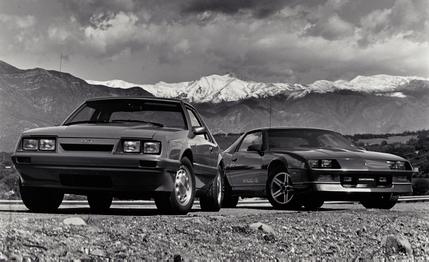 Archived Comparison
Archived Comparison
Mr. C.N. Hughes
Chief Engineer, Camaro
Chevrolet Motor Division
30003 Van Dyke Avenue
Warren, Michigan
Mr. James H. Kennedy
Manager, Mustang Development
Ford Motor Company
21500 Oakwood Avenue
Dearborn, Michigan
Gentlemen:
It has come to our attention that American auto manufacturers are now engaged in what is commonly known as a performance war. We have watched with profound interest as one and then the other of you have escalated the battle. Today, both the Camaro and the Mustang have enough power under their hoods to light a small city. The burning question is: Which car is better?
We'd love to provide the answer to that question to millions of car enthusiasts. We hereby invite you to build the fastest possible version of your sporty car for a bumper-to-bumper comparison test. Leave out the air conditioning, power ashtrays, and any other ballast that makes no functional contribution to acceleration, cornering, or braking. Of course, you should build in the best available powertrain and suspension. (We want cars within normal specifications, not factory racers.) Please make the contenders available for our evaluation in Southern California, where we'll run them through a careful technical inspection, followed by our standard battery of performance tests. In addition, we'll hot-lap Willow Springs International Raceway as part of this evaluation. Be forewarned: if either car seems to be fishy, we may be forced to use exhaust-emissions testing as a check for legality. When the results are in and the dust has settled, the victor will be crowned.
So start those assembly lines rolling! And may the best all-American GT take home all our marbles!
Sincerely,
The Editors of Car and Driver
______________________________________________
TESTEDSubmitted for your approval are two of the fastest RSVPs ever delivered to our doorstep. From Dearborn came a blood-red Mustang LX two-door sedan (the two-door body is 58 pounds lighter than the three-door hatchback), equipped with the top-of-the-line fuel-injected, 200-hp, 4.9-liter V-8, a five-speed gearbox, and all of the Mustang GT's handling hardware. An AM/FM-stereo/cassette unit and a rear defogger were its only other options.
The Chevrolet contingent anted up their new Corvette-powered missile, the 5.7-liter IROC-Z. This car was scheduled for mid-1986 production for the express purpose of wresting the pony-car acceleration crown away from the Mustang V-8.
In its IROC application, the ram-tuned, fuel-injected Corvette powerplant is rated at 220 hp (10 hp was lost to the Camaro's more restrictive exhaust system). It is backed up by a four-speed automatic transmission, because a manual gearbox hefty enough to handle the engine's torque won't fit. Nor is air conditioning an option in this model. (This keeps the 5.7-liter IROC in the desired EPA weight class.) Because of the complexities of certifying this engine-and-car combination, only 1000 big-engined Camaros were scheduled for 1986 production. Going to so much trouble for so few cars indicates just how badly Chevrolet wants revenge.
The Camaro was almost as light on options as the Mustang, but it did not lack for attention to detail. Our test car's metallic-red paint sparkled with a world-class polish job, and its throbbing exhaust suggested that its engine had been handpicked for battle. All was ready.